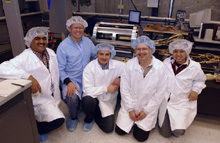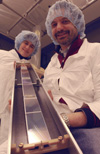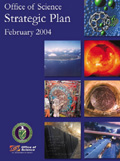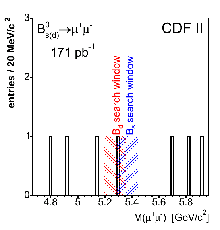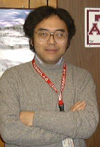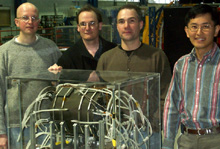 | Thursday, March 11, 2004 |
|
Thursday, March 11 THERE WILL BE NO THEORETICAL PHYSICS SEMINAR TODAY 3:00 p.m.- 5:00 p.m. Special Seminar - 1 West Long Range Planning Report Summary – Hugh Montgomery Linear Collider – Steve Holmes Proton Driver – Bob Kephart 3:30 p.m. DIRECTOR'S COFFEE BREAK - 2nd Flr X-Over THERE WILL BE NO ACCELERATOR PHYSICS AND TECHNOLOGY SEMINAR TODAY
Friday, March 12 |
|
Thursday, March 11 Corn and Green Chile Bisque Roast pork tenderloin carved to order w/pan gravy and two market sides $3.50 Pasta alla carbonara w/bacon, peas and grated parmesean over penne pasta $3.50 Lean roast beef piled high w/pepperjack and a tangy horseradish mayo $4.75 Buffalo chicken sandwich w/blue cheese and served w/fries or soup $4.75 Eurest Dining Center Weekly Menu Chez Leon |
|
Extended Forecast |
Secon Level 3 |
| Fermilab Today is online at: http://www.fnal.gov/today/ Send comments and suggestions to today@fnal.gov Fermilab Today archive Fermilab Today classifieds Subscribe/Unsubscribe to |
|
March 8 - March 10 -Fault on Feeder #35 caused problems. - Operations established 1 store during the last 48 hours. They delivered approximately 25 hours of luminosity to the experiments.
View the current accelerator update |
|
FYI: AIP Bulletin of Science Policy News, March 9, 2004 DOE Office of Science Issues Strategic Plan
The Strategic Plan was the result of many interactions with
the Office of Science's Advisory Committees, senior officials
of national laboratories and the university community, and other
interested individuals, as well as a review of policy documents.
The plan contains numerous illustrations and layman-oriented
descriptions of various programs, and can be accessed online.
|
|
Using Rare B-decays at CDF to Probe New Physics | ||
| ||
|
With the Run II data and their upgraded detectors, both CDF and DZero are
hoping to discover evidence for physics beyond the Standard Model --
the glibly named theory which presently describes sub-atomic physics.
One such piece of evidence might turn up in rare decays of particles
containing bottom quarks, such as the Bs and Bd
particles.
In the Bs the bottom-quark is paired with an anti strange-quark, while for Bd it's paired with an anti down-quark. The Standard Model predicts the Bs-->µ µ decay rate to be very small, less than about 1 in 250,000,000, and the Bd-->µ µ rate to be 40 times smaller. Recent results on the muon anomolous magnetic moment and the amount of dark matter in the universe point to supersymmetric theories which predict decay rates 10 to 1000 times larger than these. Whatever the cause, a measured rate significantly larger than
Using data through September 2003, the CDF experiment has
looked for evidence
of these decays in about 10 trillion proton-antiproton collisions. As shown
in the plot, one event was observed, which is consistent with the Standard
Model (background) expectations. We use this result to place an upper bound
on the decay rate of 5.8x10-7 (1.5x10-7) for
the Bs (Bd), thus excluding
Bs decay rates of >150 times the Standard Model and significantly
restricting the parameter space of some supersymmetric theories. These are
the best limits in the world for these decays. More data and improved
analysis techniques will help push the sensitivity ever lower, and might
ultimately reveal evidence for new physics.
| ||
| ||
|
Result of the Week Archive
|
|
Long Range Planning Report Summary Today The Long Range Planning committee will present a summary report from 3:00 p.m. to 5:00 p.m. today in One West. Live streaming video will be available at 3:00 p.m. more information
Fermilab Film Series |
